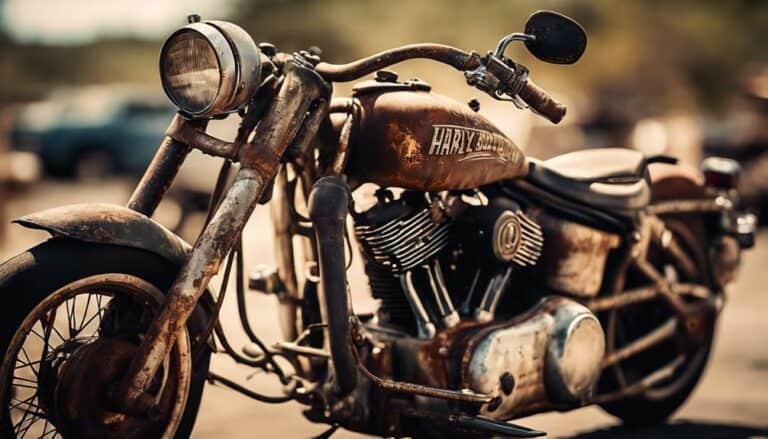When considering what constitutes a lot of miles for a Harley Davidson, it's essential to understand that mileage benchmarks can vary across different models and years.
While some smaller Harleys may hit their peak around 20,000 to 30,000 miles, larger models often go beyond 30,000 to 50,000 miles with minimal engine wear.
However, the real intrigue lies in the factors beyond just mileage that play a critical role in determining a Harley's longevity and performance.
So, how do these elements collectively influence what qualifies as a significant number of miles for your Harley Davidson?
Key Takeaways
- Regular servicing and quality parts can extend a Harley's mileage significantly.
- Adhering to maintenance schedules is crucial for longevity, especially with the Harley 103 engine.
- Reviving worn-out components through rebuilds can help increase mileage.
- Protecting your Harley from environmental damage and theft can preserve its condition for longer.
Factors Affecting Harley Davidson Mileage
Factors that impact the mileage a Harley Davidson can endure include the frequency of riding and riding style. Riding style plays a significant role in the wear and tear experienced by the motorcycle. High speeds and aggressive riding can lead to increased stress on the engine, resulting in more frequent maintenance and potentially more repairs. The overall condition of the motorcycle, especially the engine, is vital in determining how many miles it can withstand. For example, the Evolution 883cc engine tends to last fewer miles compared to the Milwaukee-Eight 107 engine due to differences in design and durability.
Regular maintenance is key to preserving the longevity of a Harley Davidson's mileage potential. Neglecting routine maintenance can result in engines being worn out quicker, leading to a decrease in gas mileage and overall performance. Factors such as terrain also play a role, as rough conditions can accelerate wear and tear on the motorcycle. By being mindful of your riding style and staying up to date on maintenance, you can optimize the mileage your Harley Davidson can achieve.
Maximizing High Mileage on a Harley
To maximize high mileage on your Harley Davidson, prioritizing regular servicing and maintenance is essential for engine longevity and overall performance. Mileage is a critical factor when it comes to the lifespan of your Harley Davidson. Take a closer look at your maintenance schedule and make sure that all service intervals are met.
Using high-quality fluids and parts is an important aspect of keeping your bike running smoothly for an extended period. When it comes to mileage, following the manufacturer's guidelines on riding habits and maintenance procedures can greatly impact the longevity of your Harley.
Different Harley models have specific design purposes, so understanding your bike's intended usage scenarios can help maximize its mileage potential. Keep your bike in top condition by paying attention to details and addressing any issues promptly. By following these tips, you can enjoy high mileage and excellent performance from your Harley Davidson motorcycle.
Longevity of Harley 103 Engine
Maximizing the longevity of your Harley 103 engine involves adhering to a rigorous maintenance schedule and utilizing quality fluids to guarantee peak performance and durability. The Harley 103 engine, a powerful V-twin known for its robustness, is designed to endure high mileage. With proper care and maintenance, this engine can exceed 100,000 miles, a proof of its durability.
Regular servicing, including oil changes, filter replacements, and overall inspections, is important to make sure the engine operates smoothly and efficiently over the long haul. Using high-quality fluids, such as synthetic oils specifically formulated for Harley engines, can also contribute to extending the lifespan of the 103 engine. This engine's reputation for reliability and consistent power delivery makes it a favorite among riders seeking a blend of performance and longevity.
Rebuilding Mileage for Harley Davidson
When rebuilding mileage for your Harley Davidson, reviving worn-out components is essential to extend the bike's lifespan. Engine rebuilds play a critical role in addressing issues like reduced power, oil consumption, and overall performance.
During a mileage rebuild, replacing critical engine parts such as piston rings, valve seals, and gaskets can greatly improve the bike's performance. Upgrading to high-performance components not only enhances power and efficiency but also guarantees a smoother ride.
Proper tuning post-rebuild is important to fine-tune the engine and maximize its potential. Testing the bike after the rebuild is important to guarantee that it operates optimally and safely on the road.
Protecting Your Harley Motorcycle
Protect your Harley motorcycle by implementing important measures to safeguard its integrity and longevity. Regularly waxing and polishing your bike helps protect the paint and finish from environmental damage. Using a motorcycle cover when storing your Harley outdoors shields it from UV rays, rain, and dust, preserving its exterior.
Applying corrosion-resistant coatings to metal parts can prevent rust and deterioration over time, extending the life of your bike. Installing a security system or using a lock can deter theft and safeguard your Harley when not in use, providing peace of mind.
Taking care of routine maintenance tasks like oil changes and inspections is important to prevent costly repairs and maintain your Harley's performance. Ensuring the Air Filter is clean and in good condition allows your bike to breathe properly and helps it shift without issues.
Conclusion
You've learned the ins and outs of what constitutes a lot of miles for a Harley-Davidson motorcycle.
Remember, mileage alone doesn't tell the whole story – factors like maintenance, storage, and riding style play a pivotal role.
So, keep those wheels turning and enjoy the ride, because as they say, the road to high mileage is paved with good maintenance.

